Combine SVG Shapes with Boolean Operations (Union, Subtract, Intersect, Exclude)

This tutorial explains how boolean operations combine shapes to create clean, production‑ready SVG icons. First, we’ll demystify the four operations—Union, Subtract, Intersect, and Exclude—with visual code examples. Then we’ll apply them in Axialis IconVectors, including how to outline strokes when needed and how to verify results in the read‑only code viewer (F3).
Understanding Boolean Operations (Concept)
Boolean operations are used to create more complex icons by combining simple shapes. They reduce overlapping paths, which helps make SVG files lighter and ensures consistent rendering across different platforms.
To perform a boolean operation, you must select at least two shapes. In this example, we’ll start with the two overlapping ellipses shown below:
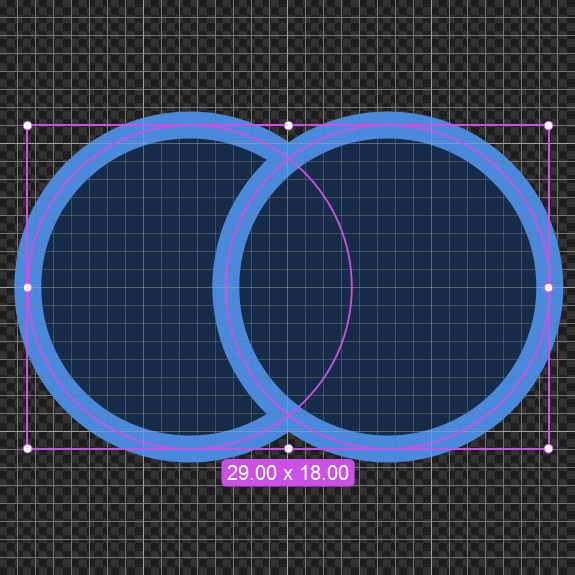
Here is the SVG code before any boolean operation is applied:
<?xml version="1.0" encoding="utf-8"?>
<svg xmlns="http://www.w3.org/2000/svg" version="1.1" xmlns:xlink="http://www.w3.org/1999/xlink"
id="Icon 1" viewBox="0 0 32 32">
<ellipse fill="#152B47" stroke="#4B89DC" stroke-width="1.5" cx="10.6" cy="16" rx="9" ry="9"/>
<ellipse fill="#152B47" stroke="#4B89DC" stroke-width="1.5" cx="21.6" cy="16" rx="9" ry="9"/>
</svg>
Union
The Union operation merges all selected shapes into a single outline. Since the action applies directly on the shapes, their stroke and fill attributes are preserved. The result looks like this:
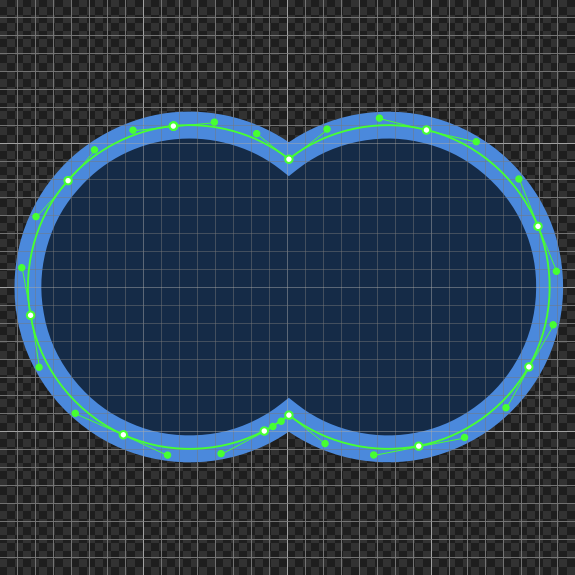
Here is the resulting SVG code. Notice how the two ellipses are combined into a single <path> element:
<?xml version="1.0" encoding="utf-8"?>
<svg xmlns="http://www.w3.org/2000/svg" version="1.1" xmlns:xlink="http://www.w3.org/1999/xlink"
id="Icon 1" viewBox="0 0 32 32">
<path fill="#152B47" stroke="#4B89DC" stroke-width="1.5" d="M9.68,7.05C7.44,7.28,5.3,8.37,
3.83,10.08C2.05,12.08,1.26,14.92,1.75,17.56C2.22,20.45,4.23,23.01,6.9,24.2C9.36,25.33,12.33,
25.25,14.73,23.99C15.21,23.74,15.67,23.45,16.1,23.11C18.11,24.69,20.81,25.32,23.31,24.83
C25.86,24.35,28.16,22.7,29.43,20.43C30.78,18.09,30.96,15.12,29.94,12.62C28.88,9.99,26.51,7.92,
23.74,7.27C21.13,6.61,18.22,7.22,16.1,8.89C14.31,7.47,11.96,6.83,9.7,7.05L9.68,7.05z"/>
</svg>
Substract
The Substract operation removes the area of the top shape from the bottom shape (useful for cutouts):
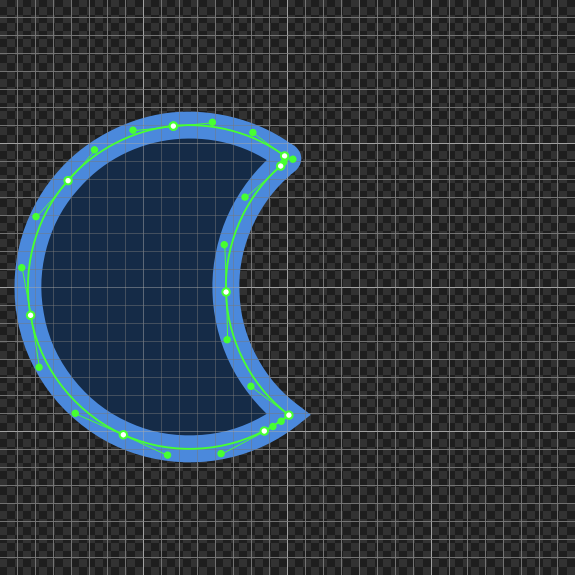
Here is the resulting SVG code. The front ellipse has carved out a cutout from the ellipse behind it:
<?xml version="1.0" encoding="utf-8"?>
<svg xmlns="http://www.w3.org/2000/svg" version="1.1" xmlns:xlink="http://www.w3.org/1999/xlink"
id="Icon 1" viewBox="0 0 32 32">
<path fill="#152B47" stroke="#4B89DC" stroke-width="1.5" d="M9.68,7.05C7.44,7.28,5.3,8.37,3.83,
10.08C2.05,12.08,1.26,14.92,1.75,17.56C2.22,20.45,4.23,23.01,6.9,24.2C9.36,25.33,12.33,25.25,14.73,
23.99C15.21,23.74,15.67,23.45,16.1,23.11C13.99,21.51,12.67,18.92,12.61,16.27C12.51,13.64,13.66,11,
15.64,9.27C15.81,9.06,16.32,8.89,15.86,8.71C14.1,7.41,11.85,6.84,9.68,7.05z"/>
</svg>
Intersect
The Intersect operation keeps only the overlapping area of all shapes:
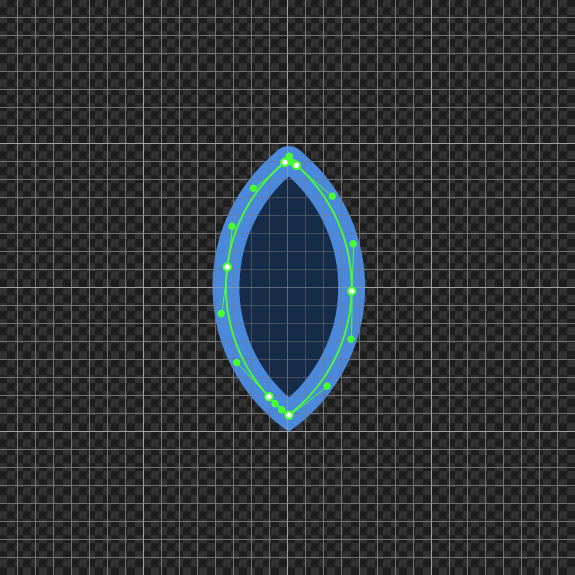
Here is the resulting SVG code. The resulting path is limited to the overlapping area:
<?xml version="1.0" encoding="utf-8"?>
<svg xmlns="http://www.w3.org/2000/svg" version="1.1" xmlns:xlink="http://www.w3.org/1999/xlink"
id="Icon 1" viewBox="0 0 32 32">
<path fill="#152B47" stroke="#4B89DC" stroke-width="1.5" d="M15.88,9.06C14.13,10.51,12.94,12.62,
12.68,14.88C12.34,17.47,13.2,20.19,14.99,22.09C15.33,22.47,15.7,22.81,16.1,23.11C18.22,21.5,19.55,
18.89,19.59,16.22C19.67,13.59,18.51,10.95,16.52,9.23C16.3,9.07,16.12,8.72,15.88,9.06z"/>
</svg>Exclude
The Exclude operation removes the overlapping areas, leaving only the non‑overlapping parts (a.k.a. XOR):
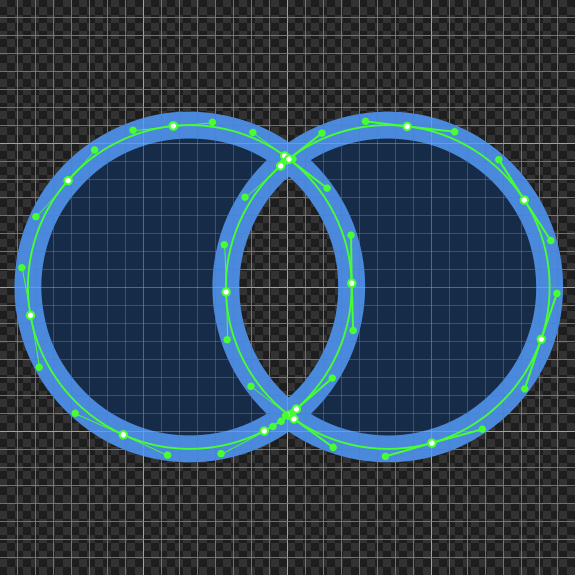
Here is the resulting SVG code. The resulting path is a compound path containing all the non-overlapping areas:
<?xml version="1.0" encoding="utf-8"?>
<svg xmlns="http://www.w3.org/2000/svg" version="1.1" xmlns:xlink="http://www.w3.org/1999/xlink"
id="Icon 1" viewBox="0 0 32 32">
<path fill="#152B47" stroke="#4B89DC" stroke-width="1.5" d="M9.68,7.05 C7.44,7.28 5.3,8.37 3.83,
10.08 C2.05,12.08 1.26,14.92 1.75,17.56 C2.22,20.45 4.23,23.01 6.9,24.2 C9.36,25.33 12.33,25.25 14.73,
23.99 C15.21,23.74 15.67,23.45 16.1,23.11 C13.99,21.51 12.67,18.92 12.61,16.27 C12.51,13.64 13.66,
11 15.64,9.27 C15.81,9.05 16.32,8.89 15.86,8.71 C14.1,7.41 11.85,6.84 9.68,7.05 Z M16.1,8.89 C18.22,
10.5 19.55,13.11 19.59,15.78 C19.67,18.41 18.51,21.05 16.52,22.77 C16.3,22.98 15.92,23.14 16.38,23.32
C18.56,24.9 21.46,25.4 24.04,24.66 C26.85,23.89 29.2,21.65 30.12,18.89 C30.99,16.35 30.65,13.41 29.18,
11.16 C27.76,8.91 25.31,7.37 22.67,7.07 C20.36,6.79 17.94,7.44 16.1,8.89 Z"/>
</svg>When to outline strokes — boolean operations work on filled geometry. If your icon uses strokes (outlines), convert them to filled paths first (see Part 2).
Doing it in IconVectors
The Source Code viewer you open with F3 (View → Source Code) is read‑only. Use the commands below to modify geometry; use F3 to verify the resulting SVG.
- Open your icon in IconVectors.
- Select the shapes you want to combine (on the canvas or in the Element list).
- Apply a boolean operation:
- Go to Path → Union (Ctrl+U), Subtract (Ctrl+I), Intersect (Shift+Ctrl+U), or Exclude (Shift+Ctrl+I).
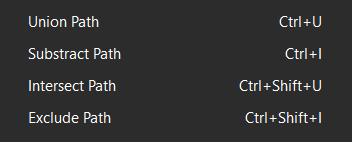
- Result: a cleaner path (fewer overlaps) ready for export.
- Go to Path → Union (Ctrl+U), Subtract (Ctrl+I), Intersect (Shift+Ctrl+U), or Exclude (Shift+Ctrl+I).
- Working with strokes? Convert them first:
- Select stroked elements.
- Choose Path → Outline Stroke to turn the visible outline into a filled path.
- Now re‑run your boolean operation on the resulting filled shapes.
- Optional: adjust thickness — use Path → Offset Path to expand/contract a path evenly before/after operations.
- Verify with
F3(read‑only). In the SVG tab you should now see fewer<path>elements and simplifiedddata. Confirm yourviewBoxis set correctly. - Export your icon:
- Use your usual export using Copy in the Code Window (F3), or File → Export → Export Minified for a compact SVG.
Troubleshooting
- Subtract removed the wrong part — order matters. The topmost selected shape is subtracted from the one below. Reorder in the Element list or change selection order.
- Operation is disabled — ensure you’ve selected paths (not groups or images). If you have strokes, run Outline Stroke first.
- Unexpected holes — check the resulting path’s
fill-rule(even‑odd vs non‑zero) in the Source Code viewer (F3). Adjust via the UI if needed. - Edges look uneven after scaling — if you’re scaling in your app, consider
vector-effect="non-scaling-stroke"(for stroked icons) or convert to filled geometry.
Start Making SVG Icons Today with IconVectors
Download the fully-functional 30‑Day Free Trial and unlock your icon design workflow.
Version 1.10 - September 17, 2025

